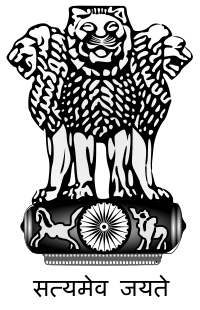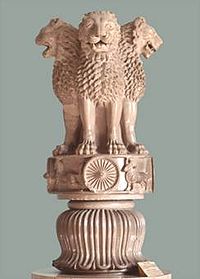- Emblem of India
-
The emblem of India is an adaptation of the Sarnath Lion Capital of Ashoka.
Contents
History
Emperor Ashoka the Great erected the capital atop an Ashoka Pillar to mark the spot where Gautama Buddha first taught the Dharma and where the Buddhist Sangha was founded. In the original there are four Asiatic lions, standing back to back, mounted on a circular abacus with a frieze carrying sculptures in high relief of an elephant, a galloping horse, a bull and a lion separated by intervening Dharmachakra or Ashoka Chakra wheels over a bell-shaped lotus. It was carved out of a single block of polished sandstone.
The four lions (one hidden from view) - symbolising power, courage, pride and confidence - rest on a circular abacus. The abacus is girded by four smaller animals - guardians of the four directions: the lion of the north, the elephant of the east, the horse of the south and the bull of the west. The abacus rests on a lotus in full bloom, exemplifying the fountainhead of life and creative inspiration. The motto 'Satyameva Jayate' inscribed below the emblem in Devanagari script means 'truth alone triumphs'.
The version used as the emblem does not include the bell-shaped lotus flower beneath. The frieze beneath the lions is shown with the Dharma Chakra in the center, a bull on the right and a galloping horse on the left, and outlines of Dharma Chakras on the extreme right and left.[1]
Forming an integral part of the emblem is the motto inscribed below the abacus in Devanagari script: Satyam eva jayate सत्यमेव जयते (English: Truth Alone Triumphs).[1] This is a quote from Mundaka Upanishad,[2] the concluding part of the sacred Hindu Vedas.
It was adopted as the National Emblem of India on 26 January 1950, the day that India became a republic.[3]
The emblem forms a part of the official letterhead of the Government of India, and appears on all Indian currency as well. It also sometimes functions as the national emblem of India in many places and appears prominently on the diplomatic and national Passport of the Republic of India. The wheel "Ashoka Chakra" from its base has been placed onto the center of the National Flag of India
The National Emblem of India
The State Emblem of India is in adaptation from the Sarnath Lion, capital of Ashoka the Emperor as preserved in the Sarnath Museum. The government adopted the emblem on 26th January, 1950, the day when India became republic. In the original Sarnath capital, there are four lions, standing back to back, mounted on an abacus with a frieze carrying sculptures in high relief of an elephant, a galloping horse, a bull and a lion separated by intervening wheels over a bell-shaped lotus. Carved out of a single block of polished sandstone, the capital is crowned by the Wheel of the Law (Dharma Chakra). In the state emblem adopted by the government of India, only three Lions are visible, the fourth being hidden from view. The wheel appears in relief in the center of the abacus with a bull on the right and a horse on the left. The bell-shaped lotus has been omitted. The words Satyameva Jayate from Mundaka Upanishad, meaning ‘Truth Alone Triumphs’, are inscribed below the abacus in Devanagari script. The emblem forms a part of the official letterhead of the Government of India, and appears on all Indian currency as well. It also sometimes functions as the national emblem of India in many places and appears prominently on the diplomatic and national Passport of the Republic of India.See also
- India
- Emblems of Indian States
- Asiatic Lion - Critically endangered, it survives only in India today
- Lion Capital of Asoka
- Ashoka Pillars
- Ashoka Chakra
- Flag of India
- Sarnath Museum
References
External links
- The State Emblem of India or the National Emblem of India
- “National Insignia”, Embassy of India, Washington D.C., USA
- State Emblem of India (Prohibition of Improper Use) Act, 2005 at the Ministry of Home Affairs web sitePDF (25 KiB)
- The National Emblem displayed on the Homepage of Ministry of Home Affairs, Government of India
- The National Emblem displayed on the Homepage of Ministry of Environment & Forests, Government of India
- For Pictures of the famous original "Lion Capital of Ashoka" preserved at the Sarnath Museum which has been adopted as the "National Emblem of India" and the Ashoka Chakra (Wheel) from which has been placed in the center of the "National Flag of India" - See "lioncapital" from Columbia University Website, New York, USA
National emblems and coats of arms of Asia Sovereign
states- Afghanistan
- Armenia
- Azerbaijan
- Bahrain
- Bangladesh
- Bhutan
- Brunei
- Burma (Myanmar)
- Cambodia
- People's Republic of China
- Cyprus
- East Timor (Timor-Leste)
- Egypt
- Georgia
- India
- Indonesia
- Iran
- Iraq
- Israel
- Japan
- Jordan
- Kazakhstan
- North Korea
- South Korea
- Kuwait
- Kyrgyzstan
- Laos
- Lebanon
- Malaysia
- Maldives
- Mongolia
- Nepal
- Oman
- Pakistan
- Philippines
- Qatar
- Russia
- Saudi Arabia
- Singapore
- Sri Lanka
- Syria
- Tajikistan
- Thailand
- Turkey
- Turkmenistan
- United Arab Emirates
- Uzbekistan
- Vietnam
- Yemen

States with limited
recognition- Abkhazia
- Nagorno-Karabakh
- Northern Cyprus
- Palestine
- Republic of China (Taiwan)
- South Ossetia
Dependencies and
other territoriesCategories:- National emblems
- National symbols of India
- Indian coats of arms
- Indian government stubs
Wikimedia Foundation. 2010.


